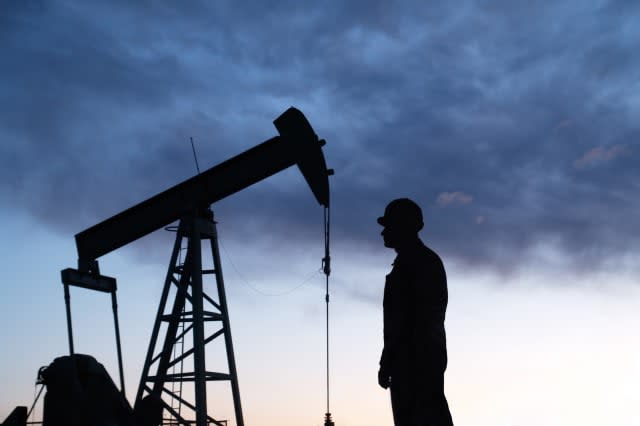The oil price may have bottomed out - but there could be turbulence ahead

That's it. We've seen the bottom for the oil market.
At least, that's what two of the biggest oilfield services companies in the world – Schlumberger and Halliburton – believe.
"We now appear to have reached the bottom of the cycle", said Schlumberger boss Paal Kibsgaard last week, presenting the second quarter results. Meanwhile, Halliburton boss David Lesar said: "Our customers are thinking about growing their businesses again, rather than being focused on survival."
Are they right?
The big difference US shale makes to the oil price
As Eoin Treacy points out on FullerTreacyMoney.com, Schlumberger and Halliburton aren't exactly early in calling the bottom in the oil market – after all, "prices almost doubled this year before entering the current pullback".
Brent crude hit a low of just below $30 a barrel near the start of this year. It made it as far as just over $50 a barrel a few months ago, and since then has started to lose traction, dipping to around $45 now.
However, "what it does tell us... is they are potentially seeing greater interest from producers in the types of services they offer".
That's not surprising. One of the most interesting things about "fracking" in the US is the way in which it may have transformed the dynamics of the oil market.
In effect, "fracking" can be turned off and on more readily than most forms of oil production. When oil prices cratered, producers in the US eventually either chose or were forced to cut back on production. It simply wasn't viable.
As a result, lots of wells in the US that had been drilled were left idle – no one was trying to pull oil out of them. This has been given the catchy term, the "fracklog" – wells that have been drilled, but are yet to be hydraulically fractured.
However, notes Bloomberg, in the first quarter of 2016, this "fracklog" – of around 4,200 wells – stopped growing. Instead, as oil prices picked up, some companies started to get to work on fracking them.
The Baker Hughes drill-rig count – which looks at active drilling rigs in the US – collapsed from around 1,800 to 700 across 2015. But it's now starting to pick up – rising from 404 at the end of May to 447.
Bloomberg Intelligence analyst Andrew Cosgrove reckons that with oil prices at current levels ($40 to $50 a barrel), the majority of wells in the most productive parts of the US shale territories are worth tapping for oil.
So you can see why oilfield services providers might be feeling more upbeat about the outlook (although this is coming from a very low base, remember – both Halliburton and Schlumberger also announced further job cuts in their latest results). Their business picks up when oil companies decide it's worth drilling again, and that is basically a function of the price of oil.
The risk, of course, is that as the oil price recovers, you get more production coming back online, supply goes up again, and prices take another hit. Cosgrove, for example, reckons that by the end of September this year, "the bullish catalyst of falling US production will be all but gone". US production will be "flatlining" rather than declining.
That takes you right back to where we were before. Too much supply hits the oil price, a low price makes it unproductive to keep fracking, and business starts to drop off again.
It's not as though the US is hugely short of oil at the moment either, particularly given what normally happens at this time of year, says Bloomberg. In August and September, US petrol consumption tends to drop off "as vacationers return home, and refiners use that dip to shut for seasonal maintenance."
US petrol stockpiles are at their highest for this time of year since records began in 1990. So you might see refiners shut down for even longer than normal, which in turn means less demand from them for crude oil to turn into petrol.
The oil market could be in for some turbulence
So there are lots of reasons to be edgy about the potential for the oil market.
That said, it's also possible to over-egg the potential for another collapse. The thing about shale wells, as Lex in the FT notes, is that they "tend to produce a lot of oil quickly, but decline rapidly thereafter. Production can often halve in the first year before stabilising."
Researcher Evercore ISI reckons that the production from new wells will merely offset the decline in old ones, reports Bloomberg. So concerns of the oil supply glut may be over the top.
However, if one thing has been made clear in the last two years or so, it's that reliable forecasts of what the oil price will do next are hard to come by, regardless of how many facts and figures an individual expert can marshal.
The upshot is that as an investor, I'd be cautious about betting on smaller oil companies and the oilfield services plays just now. They've enjoyed a strong rebound, and there's a lot of potential for them to suffer a big hit to sentiment if oil does keep declining – which is partly a function of the stronger US dollar as much as anything else.
If you've made money in any of these ones, it might be worth locking in some profits now. If you're invested in the bigger players primarily for dividend purposes, though – such as Royal Dutch Shell – I'd be happy to hang onto them.




